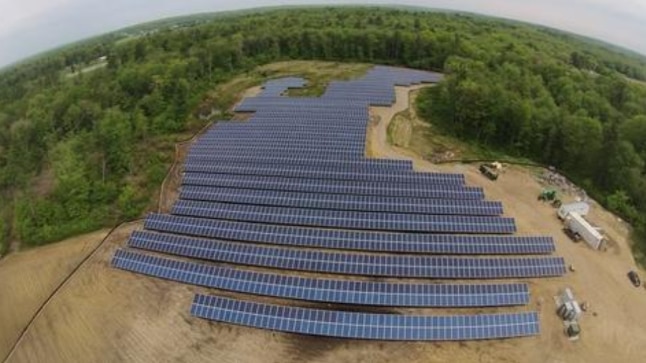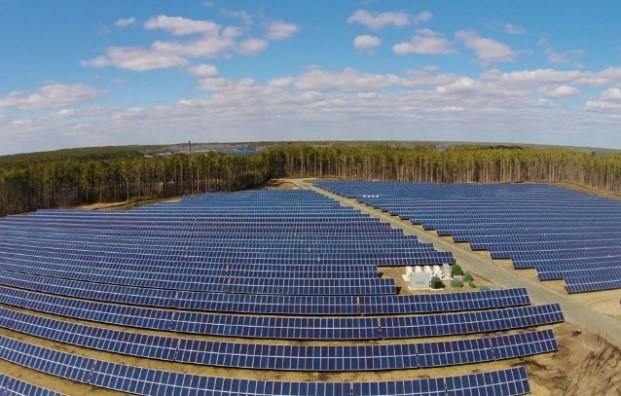Eligibility
Under Massachusetts law, “generation company” is defined as “a company engaged in the business of producing, manufacturing or generating electricity or related services or products, including but not limited to, renewable energy generation attributes for retail sale to the public.”75 Many of the state’s large-scale solar farms and facilities with a capacity of over 1 megawatt (MW) are operated by developers that fit the legal definition of “generation company.” (For reference, a 1 MW solar facility in Massachusetts, which produces 1,000 kilowatts [kW] of electricity, can power over 164 households).76
These large solar companies and developers, however, cannot participate in net metering or own net metering facilities, according to regulations promulgated by the Department of Public Utilities.77 Net metering allows owners of solar facilities to offset the cost of their electric bills by transferring any excess energy produced by their renewable energy facilities back to their electric companies for a credit.78 In decades past, it was not uncommon for residential installations to directly power hot water heaters. Today, the connection goes outside the home to the electric grid. Electric customers are therefore billed for the net difference between their electricity usage and what they produce (or receive net metering credits if their electrical production outpaces their usage). Net metering incentivizes consumers to build their own small solar facilities and also permits customers of community solar projects to sell electricity back to the grid.
Although net metering was initially established for small (under 30 kW) solar installations, an expansion of the program in 2009 allowed privately owned midsized solar farms (up to 2 MW) to participate.79 However, larger solar installations and generation facilities cannot take advantage of this program.
PILOT Agreement Components
Under a PILOT agreement, the generation company must make payments that are the “equivalent of the property tax obligation based on full and fair cash valuation.”80 According to the DOR’s Division of Local Services (DLS), the following are among the components necessary for a solar facility PILOT agreement:
- a mechanism that represents taxes at full and fair cash valuation;
- estimated projections by municipal assessors of the initial cash valuation and tax payments of the renewable energy system for each year of the PILOT agreement;81
- a formula or fixed values to determine values of the solar facility over the life of the agreement;
- a term limit for the PILOT agreement with the generation company;
- approval of the agreement by the municipality’s legislative body or authorization of the chief executive officer to negotiate on the municipality’s behalf;
- documentation of the agreement provided to the DOR’s Bureau of Local Assessment; and
- recordkeeping and reporting of the agreement values.82
The PILOT agreement customarily provides that payments do not decrease as the value of the facility declines over time through depreciation. The PILOT can be structured with consistent payments to avoid larger payments at the start of the agreement. PILOT agreements can last for a “reasonable term,” but the DLS recommends they not last longer than the useful life of a solar installation (generally between 20 and 30 years for the average solar PV system).83
If the solar developer owns the land on which the solar equipment is placed, the equipment can be assessed as real property if it is to remain on the site for its useful life, or as personal property if the equipment will be replaced periodically.84 Some issues arise, however, when the owner of the land is not the solar developer that provides the equipment. If the solar equipment is treated as real estate, the landowner will be taxed for the increase in the property’s value caused by the presence of the equipment. If the equipment is treated as personal property, installations are assessed to the solar developer, not the landowner.85
Taxable Status of Solar Arrays (M.G.L. c. 59, § 5, cl. 45)
The provisions of M.G.L. c. 59, § 38H(b) are undercut by a property tax exemption provided under M.G.L. c. 59, § 5, cl. 45 for any
[s]olar or wind powered system or device which is being utilized as a primary or auxiliary power system for the purpose of heating or otherwise supplying the energy needs of property taxable under this chapter; provided, however, that the exemption under this clause shall be allowed only for a period of twenty years from the date of the installation of such system or device.86
The original intent of Clause 45, which was enacted in 1975 and revised in 1978,87 was to provide an exemption to owners of residential properties who wanted to use off-grid rooftop panels to supply electricity to their properties.
Clause 45, however, has generated a great deal of controversy in the current age of solar farms. Between 2014 and 2017, the ATB rendered decisions on cases from the towns of Westborough, Swansea, and Barre and interpreted the clause as exempting both residential and commercial solar arrays from property taxes.88 The ATB held in each of these decisions that a solar operator cannot be taxed if its solar facility is supplying power to a property that pays taxes, regardless of whether the energy generated is used on the property where the facility is located or on another property.89
The ATB’s interpretation of Clause 45 in these cases has also allowed solar developers that participate in net metering and supply electricity to other properties through the electrical grid to be eligible for the solar exemption.90 In 2020, the ATB also rendered decisions on cases from the towns of Framingham and West Bridgewater and held, based on the language of Clause 45, that a solar facility that supplies net metering credits for nontaxable properties such as municipal buildings is taxable.91
The ATB decisions have increased the importance of PILOT agreements as a method to guarantee a steady source of revenue to communities from solar installations.92 Municipalities can negotiate a PILOT agreement with a solar developer, regardless of whether the installation qualifies for the exemption. Although some developers recognize the need to pay their fair share of taxes, others have sought to avoid or minimize property taxes on their solar installations. This effort has led to difficult interactions between municipal officials and solar developers in recent years, such as the following:
- disputes over assessments of equipment;
- solar developers requesting tax abatements on equipment;
- moratoriums on solar installations after multiple agreements with developers; and
- a reluctance in some municipalities to participate in PILOT agreements.93
Case Study: Solar Facility PILOTs in New York
New York provides a different model for dealing with the taxation of solar facilities. New York has a 15-year real property tax exemption (NY RPTL § 487) for renewable energy systems.94 An exemption is granted for the “value that a solar electric system adds to the overall value of the property.”95 Unlike those in Massachusetts, municipalities in New York have the choice to opt out of the exemption for renewable energy projects in their communities. If a city or town does not opt out, it may participate in PILOT agreements with solar developers overseeing projects larger than 1 MW.96
In order to help New York communities that are having trouble assessing solar facilities or developing PILOT agreements, the New York State Energy Research and Development Authority established a Solar PILOT Toolkit for local governments.97 The toolkit includes a template for a “Model Solar PILOT Law,” which would allow a municipality to establish the legal authority for a jurisdiction-wide agreement process with developers. There is also a “Model Solar PILOT Agreement” for communities that would rather negotiate terms and conditions on a project-by-project basis, as well as a calculator that helps municipalities calculate PILOT rates with solar developers.
| Date published: | December 10, 2020 |
|---|

